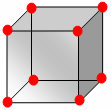Full Factorial
Evaluates all possible combinations of input variable levels. This will resolve all the effects and interactions.
| Run Number | A | B | C |
|---|---|---|---|
| 1 | 1 | 1 | 1 |
| 2 | 1 | 1 | 2 |
| 3 | 1 | 1 | 3 |
| 4 | 1 | 2 | 1 |
| 5 | 1 | 2 | 2 |
| 6 | 1 | 2 | 3 |
| 7 | 2 | 1 | 1 |
| 8 | 2 | 1 | 2 |
| 9 | 2 | 1 | 3 |
| 10 | 2 | 2 | 1 |
| 11 | 2 | 2 | 2 |
| 12 | 2 | 2 | 3 |

Figure 1.
Usability Characteristics
- For a case with k input variables, each at L levels, a Full Factorial design has L^k runs. For studies with a large number of input variables and levels, the total number of runs is larger. For example, for a study with eight factors and each with three levels, 6561 runs are needed (3^8 = 6561).
- This method may be practical for studies where there is a small number of variables and each variable has two levels, such as yes or no; -1 or 1. This method is not practical for most CAE applications where there are many factors possibly at several levels, and the simulations are costly.
- If the number of levels is not equal across variables, then the total number of runs is calculated by the product of the L^k terms. For example, consider eight variables: five variables with two levels, two variables with three levels and one variable with four levels. The number of full factorial runs is 1152 = 2^5 * 3^2 * 4^1.
- Any data in the inclusion matrix is combined with the run data for post-processing. Any run matrix point which is already part of the inclusion data will not be rerun.
Settings
| Parameter | Default | Range | Description |
|---|---|---|---|
| Number of Runs | 2-1,000,000 | Number of new designs to be evaluated. is the number of input variables with i levels. This number is determined automatically based on the number of input variables and levels. | |
| Use Inclusion Matrix | Off | Off or On | Concatenation without duplication between the inclusion and the generated run matrix. |